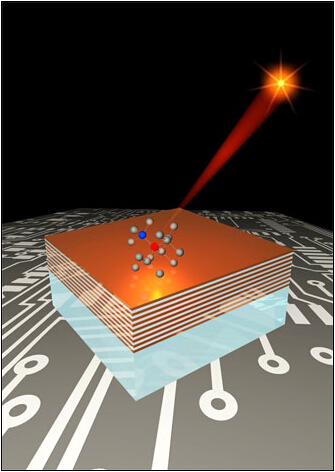
Purdue University in the U.S. released a research that attaches nano diamond with nitrogen-vacancy center to metamaterials made of TiN and AlxSc1-xN , and pumps by laser so as to enhance single photon emission of metamaterials.
Purdue University in the U.S. released a research that attaches nano diamond with nitrogen-vacancy center to metamaterials made of TiN and AlxSc1-xN , and pumps by laser so as to enhance single photon emission of metamaterials. This is recognized as a significant step towards the development of quantum computer and quantum communication technological device. The work was a collaboration of researchers from Purdue, the Russian Quantum Center, Moscow Institute of Physics and Technology, Lebedev Physical Institute and Photonic Nano-Meta Technologies Inc.
According to Wikipedia, metamaterials are artificial materials engineered to have properties that have not yet been found in nature. Potential applications of metamaterials are diverse and include remote aerospace applications, sensor detection and infrastructure monitoring, smart solar power management, public safety, radomes, high-frequency battlefield communication and lenses for high-gain antennas, improving ultrasonic sensors, and even shielding structures from earthquakes.
Professor Alexander Kildishev says, "Experiments indicate that placing nanodiamond-based single photon emitters on surface of hyperbolic metamaterials can improve the generation of single photons substantially, and that single photon emitters can be used to build highly efficient room temperature CMOS-compatible single-photon sources."

A nitrogen-vacancy center is an atomic-scale defect formed in the diamond lattice by substituting a nitrogen atom for a carbon atom and creating a neighboring void in the lattice. Placing nano diamond with nitrogen-vacancy center on the surface of the hyperbolic metamaterial can not only enhance the emission of photons, but also change the pattern of light emitted mode, which is important for the development of quantum devices.
Because the studied system represents a stable source of single photons that functions at room temperature, it is potentially practical for commercial applications. When exposed to a laser light, the system rises from its "ground state" to an excited state, which causes it to spontaneously emit a photon.
Further research may include improvement of the system by making use of hyperbolic metamaterials, nano antennas or alternating layers of nitrides that enable unprecedented control of light. Besides that, researchers plans to improve the "spin properties" of the system with nitrogen-vacancies and to study the optical contrast between the up and down states.